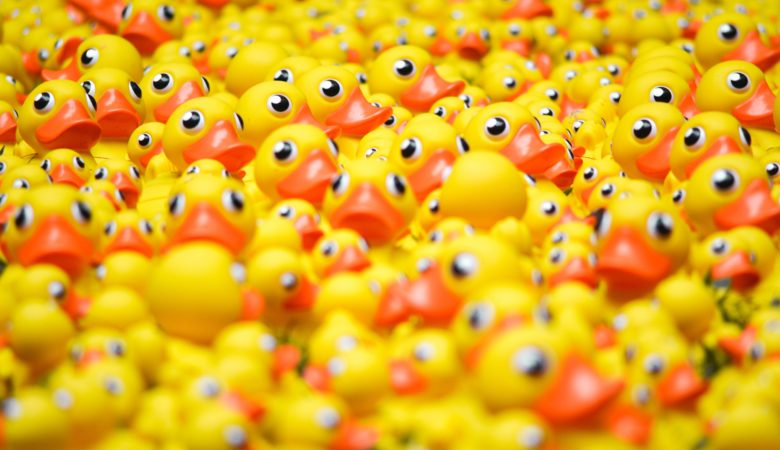The Story of 28,000 Rubber Ducks and What They Tell us About Ocean Currents

Imagine walking along a beach in Chile or England or Alaska and coming upon a simple rubber duck washed up on the shore. You might think nothing of it—something a child dropped while they were playing in the water, right? That might be true. Or, it might be a rubber duck from one of the largest unintended ocean current studies of all time. This is the story of the Friendly Floatees.
Bath toys overboard!
In 1992, a shipping barge headed from China to the U.S. encountered a major storm in the Pacific Ocean. Amidst the rocking and tossing of the waves, several shipping containers fell overboard, spilling their contents into the sea. Among them was a shipment of 28,000 plastic rubber ducks and other bath toys.
Rather than sink to the bottom of the sea, the rubber ducks, turtles, beavers and frogs floated to the surface and began an epic voyage of their own around the world, carried forth by ocean currents. Now, two decades from the initial spillage, these toys are still washing up on beaches around the world. They’re sun-faded, battered and sometimes barely recognizable—and they’re often a long way from where the initial spill happened in the Pacific, where the 45th parallel intersects the International Date Line.
Nicknamed the “Friendly Floatees” (the brand name was Floatee), beachcombers and oceanographers started finding these bath toys all around the world, prompting an unconventional study into the nature of ocean currents and the factors that influence them.
An unconventional way of tracking ocean currents
For centuries, oceanographers and marine scientists have tested ocean currents in roughly the same way: by dropping a beacon in the ocean and seeing where it eventually washes up. Often, it’s done with a thousand or so beacons at a time, with the expectation that only a few will ever be recovered. What makes the story of the Friendly Floatees so unique is its mammoth data sampling size: 28,000 unindividual toys went overboard during the storm!
The first recorded crop of Friendly Floatees washed up just nine months later on the shores of Sitka, AK—roughly 2,200 miles from where they were deposited into the ocean. Then, another bunch washed up on the shores of Shemya Island, AK, 3,200 miles from the spill site. Eventually beaches in Kamchatka, Japan began to see the rubber bath toys wash ashore! Years later, another crop again graced the shares of Alaska.
This circuit—Alaska to Japan, then back again—provides important insight into ocean gyres: circular ocean currents that recirculate over certain areas of the globe. In this case, the rubber ducks and other plastic bath toys were part of the Subpolar Gyre.
But the ducks weren’t confined to the Subpolar Gyre. In fact, due to the nature of where they were cast into the ocean, many also split off into the Subtropical Gyre—a gyre with a huge circular pattern that touches the equator and intersects other gyres. This is evidenced by the fact that the ducks started washing up all around the world over the next three to five years!
Since the spill—and to this day—ducks continue to wash up on every continent in the world, sometimes in groups and sometimes all by themselves. A lone duck confirmed to be a Friendly Floatee was found in Maine in 2003, the same year a frog was discovered on the shores in Scotland. There are likely more trapped in polar regions, frozen until they’re recirculated into a gyre again. Even more are likely trapped in the Texas-sized garbage patch in the Pacific Ocean. And while it’s impossible to ever account for them all, the Friendly Floatees we do have can tell us a lot about ocean currents.
Ducks are a friend of OSCAR
Oceanographers and marine scientists were quick to recognize the potential of 28,000 rubber bath toys-turned-flotsam (floating trash). As ducks were discovered on shores, beachcombers reported their location to oceanographer Curtis Ebbesmeyer, who, in turn, plugged them into Ocean Surface Currents Simulation (OSCAR) software. Using wind data and other ocean current variables, OSCAR was able to map the suspected route of a duck from the point of origin to the point of discovery. In doing so, it cast a light on the complexities of ocean currents not only in the pacific, but worldwide.
Today, we know more than ever about ocean currents, thanks largely to the Friendly Floatees. In fact, there’s even an interactive map devoted to tracking the path of flotsam, using data provided chiefly by the ducks! Click here to see the path of a rubber duck cast overboard.

